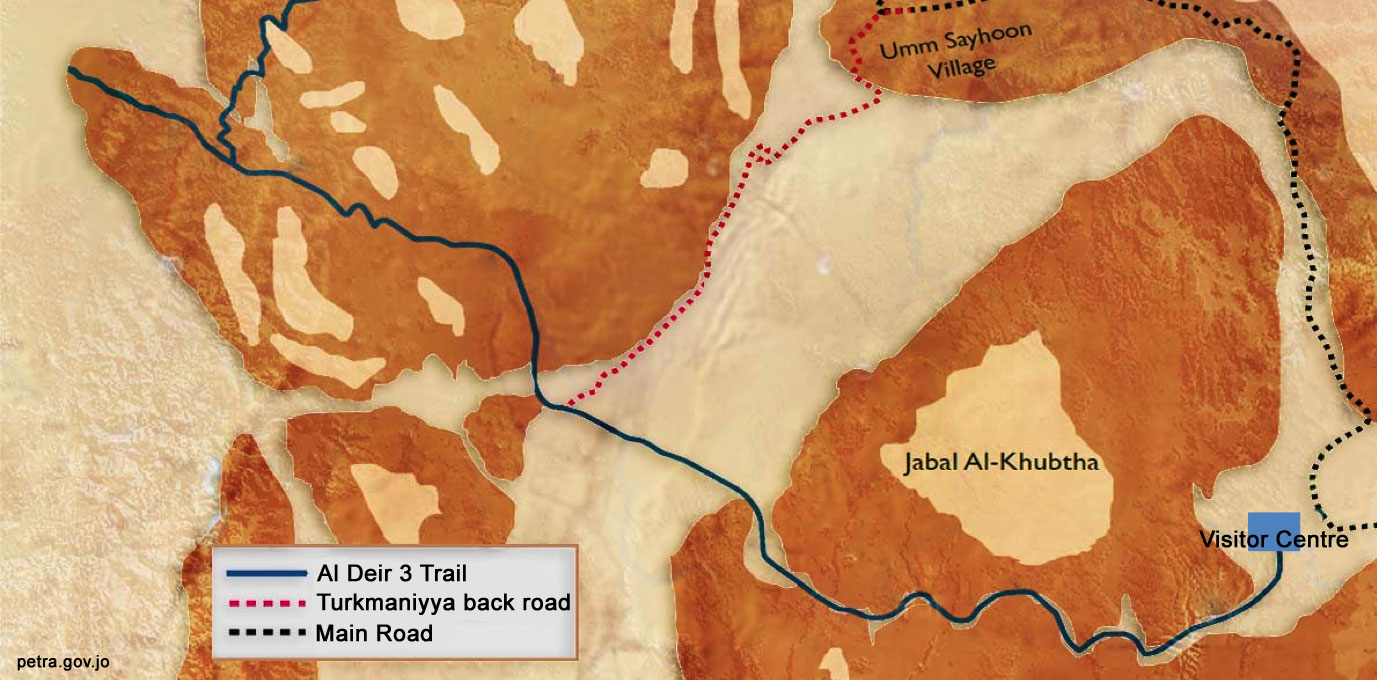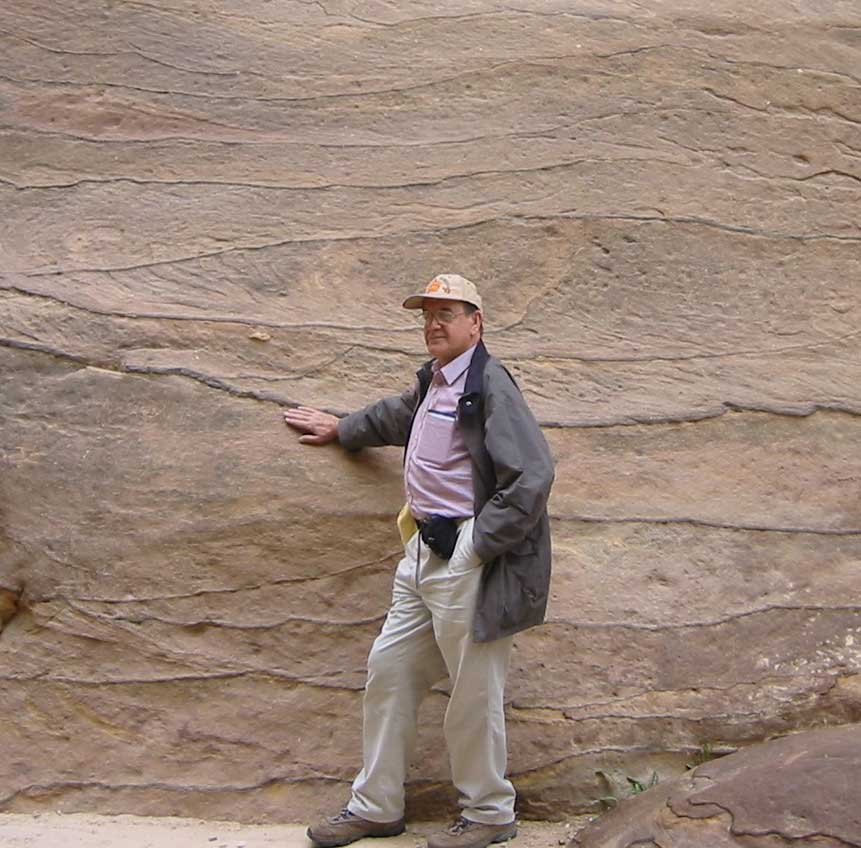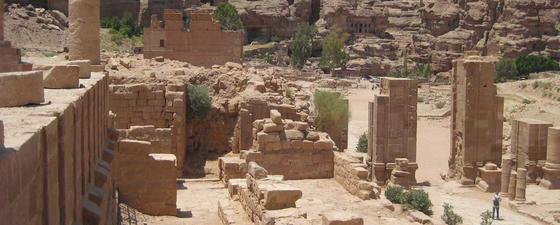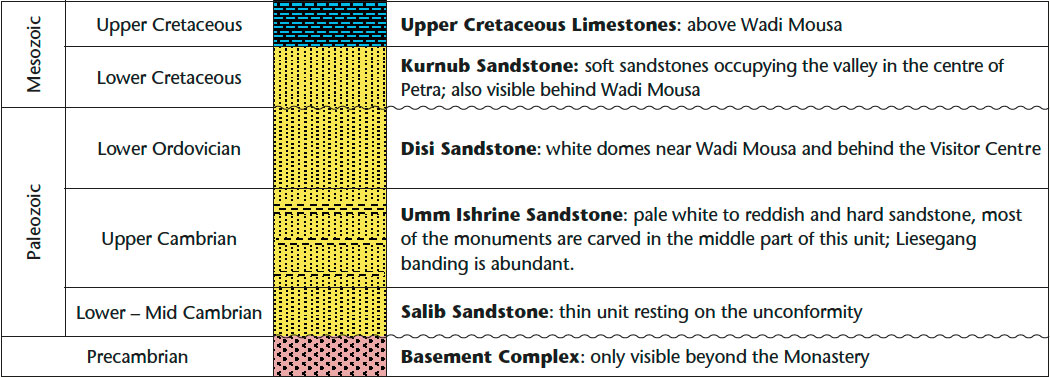The present site of Petra was originally built by the Nabataean Arabs during the 4th century BC, and was known in Arabic as Sila’a سلع, and Ar Rakeem الرقيم, or biblically as ‘Rqm’, which all mean ‘cut in rock’. The site was conquered by the Romans in AD 106, and was renamed in Greek as Petra, or in Arabic Al Betra البتراء, which also means cut in rock. It is believed that Petra was destroyed by several earthquakes, ending in complete destruction and eventual evacuation during the 6th century AD.
Petra is located in the heart of the mountainous desert of southern Jordan, half way between the Red Sea and the Dead Sea, but importantly, was adjacent to an ancient route down from the high plateau eastwards to Wadi Araba. The site can also be reached from the city of Ma’an to the east. The town surrounding the site of Petra is called Abu Mousa, as well as the valley (wadi) leading to Petra. In detail the site occupies an open valley (occupied by the town itself) surrounded by mountains, which were used for religious ceremonies, tomb building and water collection in cisterns. Routes through the mountains follow deep gorges or ‘siqs’. Although the formal entrance was through the main Siq in the south, general access is also possible from the north.
Although Petra is now a major archaeological tourist destination, receiving nearly one million visitors each year, in this article we will highlight the geological perspective of Petra.
Petra’s Geology
 The Kasneh (Treasury) shining in the sun at the end of the long dark canyon known as the Siq – surely one of the most impressive and iconic sights in the world. Source: Anne Whaley SousouThe mountains to the south of Petra are composed of Precambrian igneous rocks of the Aqaba Granite Complex, cut through by a series of intrusive dikes. These are unconformably overlain by the massive quartzose sandstones of Middle Cambrian to Lower Ordovician age which make up the rocks and monuments of Petra. The properties of the rock itself may have persuaded the Nabataeans to site their city here, as it was evidently suitable for rock carving and excavating, and also pleasing to look at. After 2,000 years, however, much of the worked and excavated stone is showing signs of decay, not least through the footsteps of many tourists.
The Kasneh (Treasury) shining in the sun at the end of the long dark canyon known as the Siq – surely one of the most impressive and iconic sights in the world. Source: Anne Whaley SousouThe mountains to the south of Petra are composed of Precambrian igneous rocks of the Aqaba Granite Complex, cut through by a series of intrusive dikes. These are unconformably overlain by the massive quartzose sandstones of Middle Cambrian to Lower Ordovician age which make up the rocks and monuments of Petra. The properties of the rock itself may have persuaded the Nabataeans to site their city here, as it was evidently suitable for rock carving and excavating, and also pleasing to look at. After 2,000 years, however, much of the worked and excavated stone is showing signs of decay, not least through the footsteps of many tourists.
The impressive gorges were formed when the force of desert flash floods over many thousands of years exploited lines of weakness in the rocks such as faults, joints and fractures, a process which is still continuing today.
A Walk Through Petra
Click the information points below for a virtual tour.

 1.
1. 2.
2. 3.
3. 4.
4. 5.
5. 7.
7. 8.
8. 9.
9. 10.
10. 11.
11. 12.
12. 14.
14. 6.
6. 13.
13.An Essential Visit
The sedimentary sequence in Petra and the surrounding area along the Dead Sea in southern Jordan is a must-visit for amateur and professional geologists. For geological students, it is field laboratory to observe and study geological features and sedimentary structures. In sequence stratigraphy, it is a surface analogue to correlate seismic stratigraphy and borehole information, while for petroleum geologists, the sequence at Petra is an excellent example to help understand reservoir geometry.
A Note From The Author
 Source: Munim Al RawiMy first visit to Petra was in January 1965, with the graduation class of the Geology degree at the University of Baghdad, and was led by the late British Professor C.M.G. Bolton, accompanied by other staff members. Petra at that time was not a proper tourist destination. We observed the fascinating Cambrian sandstone formations and learnt the fundamentals of the geology of the Arabian Peninsula from the Precambrian basement complex to the Tertiary rifting of the Gulf of Aqaba and the Dead Sea. Between 1994 and 2005, I made several further visits to Petra and southern Jordan, privately and accompanying oil companies, culminating in a recent publication on the hydrocarbon potential of Jordan in Naylor et al. 2013.
Source: Munim Al RawiMy first visit to Petra was in January 1965, with the graduation class of the Geology degree at the University of Baghdad, and was led by the late British Professor C.M.G. Bolton, accompanied by other staff members. Petra at that time was not a proper tourist destination. We observed the fascinating Cambrian sandstone formations and learnt the fundamentals of the geology of the Arabian Peninsula from the Precambrian basement complex to the Tertiary rifting of the Gulf of Aqaba and the Dead Sea. Between 1994 and 2005, I made several further visits to Petra and southern Jordan, privately and accompanying oil companies, culminating in a recent publication on the hydrocarbon potential of Jordan in Naylor et al. 2013.
References
Dumon, F. C., 2010. The Cambro-Ordovician Sequence in the Petra Area, Jordan – Sedimentology and Stratigraphy. MSc Thesis. TA Report number : AES/TG/10-38. Section for Applied Geology, Department of Applied Earth Sciences, Delft University of Technology.
Makhlouf, I., & Abed, A. (1991). Depositional facies and environments in the Umm Ishrine Sandstone Formation, Dead Sea area, Jordan. Sedimentary Geology, Amsterdam, Vol.71, pp.177–187.
Naylor, D., Al-Rawi, M., Clayton, M., Fitzpatrick, M.J., and Green, P.F., 2013. Hydrocarbon Potential of Jordan. J.P.G., Vol. 36 (3), July 2013, pp. 205–236.
Selley, R. (1970). Ichnology of Paleozoic sandstones in the southern desert of Jordan: A study of trace fossils in their sedimentological context. In: Crimes, T.P. and Harpe, J.C. (eds), Trace Fossils.
Selley, S. (1972). Diagnosis of marine and non-marine environments from the Cambro-Ordovician sandstones of Jordan. J. Geol. Soc. London, Vol. 128 , pp. 135–150.






